This is the kind of game that makes me wish that I had kids so I wouldn't feel so silly for wanting to play it as badly as I do.
Sesame Street: Once Upon a Monster Review
|
|
See PixlBit's Review Policies

On 10/23/2011 at 12:00 PM by Chessa DiMola A bright, wholesome, and delightful experience from front to back that won't disappoint. |

All parents with young children should absolutely invest in the Kinect set-up and Once Upon a Monster.
I was one of the very few people I know who did not grow up watching Sesame Street. As such, I never fully understood the dedication and nostalgia that people who did grow up watching it had for the not-for-profit, educational television show. Never fully understood, until having my own child, I should say. Although my son, Nicholas, is only ten months old, his smile widens and his eyes brighten every morning at 10AM when Sesame Street comes on the air. As I've watched and enjoyed the program for the last few months, I've come to understand why it has been loved by generations. Armed with my new found love for, and expertise on the series, I was genuinely excited to try out Double Fine's newest game based on the beloved TV show, Once Upon a Monster. From beginning to end, the game is a joyous experience full of color and endearing characters that was clearly not just created to be a fun game, but one that is designed to encourage families to play together.
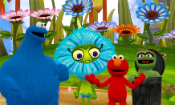
The storyline for Once Upon a Monster comes from a storybook, which Cookie Monster explains at the beginning was one of his favorites as a child. After a silly little exchange between Elmo and Cookie Monster, players are introduced to the book, which acts as the level selection area.
The game is segmented into six different chapters, each of which is split into pages that act as subsections of the overall level. Since every level focuses on a particular monster and their story, the gameplay will reflect this, offering between five and six story book pages based around the chapter's theme.
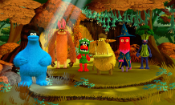
Unlike the traditional children's video game, Once Upon a Monster targets real emotional issues that young children are very likely to experience. Overcoming shyness, making friends, keeping the environment clean, being creative, and motivating other people are just some of the valuable lessons that will hopefully teach and inspire small children as they play.
Since most video games developed for children tend to be easy and either educational or silly, Once Upon a Monster truly shines in its ability to take all of these concepts and create a title that is more accurately described as an interactive experience. By utilizing the hands-free control scheme made possible with Kinect, Once Upon a Monster is able to stimulate children in a much more well-rounded manner through very simple, yet physically and mentally engaging gameplay.
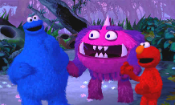
As previously stated, the gameplay throughout each chapter will tie in neatly to the chapter's overall theme. There are 17 different “mini-games” in total for children to participate in, and of the seventeen, sixteen require them to move their bodies, which encourages constant physical movement throughout. Some will require drumming to a beat, while others will challenge players to jump, duck, and dodge obstacles all while raising their arms in order to collect items. In addition to these examples, Once Upon a Monster will have children shouting to their new friends, flapping their arms to fly, understanding the basics of musical notes and tuning, running in place, pulling weeds, watering plants, tossing objects, dressing up their characters, laughing at the silly humor, staring in awe at the vivid gorgeous presentation, and begging their parents to play with them.
Although the valuable life lessons and physically stimulating gameplay are enough to carry this delightful game all on their own, the game really shines in its simple multiplayer system. By now, most gamers know how time consuming and cumbersome it can be to participate in a multiplayer experience. For a children's game, that type of complexity is unacceptable and often confusing.

With Once Upon a Monster, joining in with another person is as simple as walking into the Kinect's view. As a matter of fact, the process is so seamless that there's barely any down time. If a commitment arises and you need to excuse yourself for a moment, merely step out of the Kinect's view, and your child is back to having fun on their own in no time at all.
Naturally, all of the physical activity required by the game would be no fun at all if the motion sensing was not spot-on. Although I occasionally encountered a very brief rough patch, overall every mini-game I tried worked flawlessly.
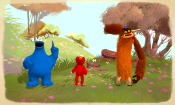
Since every chapter is split into sections, Once Upon a Monster makes it very easy for parents to limit the amount of play their child can have in one sitting. While I may have blasted through each section with no effort, I can see where small children – being more uncoordinated – will take their time and be more deliberate and selective with their actions. Even better, is that the story will progress slightly between each section, giving children a sense of accomplishment as well as something to look forward to.
In addition to all of the wonderful elements that comprise Once Upon a Monster, its ability to encourage the child playing made a large impression on me. Children will never be criticized or penalized for doing something wrong, but rather reassured that they are capable of completing the task, and inspired to try again.
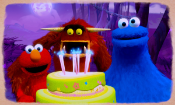
In order to reward initial success, Once Upon a Monster awards the players up to five stars based on their performance. This serves not only to reward children for their efforts, but also as a means of allowing them to go back through particular sections in order to do better. Earning stars will unlock special bonus content, including behind the scenes developer interviews detailing Double Fine's journey through creating Once Upon a Monster.
As a parent, not only is Once Upon a Monster an experience that I'm excited to share with my son, but one that I believe will be beneficial to him. There are dozens of children's games available that teach the ABCs, how to count, and dozens more that are silly mindless fun. However, it's rare to find a game that will not only teach, but speak to children in a mature way on their own level.
Years of failed attempts at making good video games based on already established intellectual properties tells us that Double Fine clearly had their work cut out for them. Even more intimidating must have been working with a show and its characters that have taught and entertained audiences for 42 years. While I suppose every video game is an interactive experience at its core, Once Upon a Monster takes it one step further, incorporating game elements with emotional life lessons, encouragement, constant praise, alond with endearing worlds and characters. It's not just a game that parents might want to pick up, but one that they should, as it is hands down the best gaming experience available for families with young children.








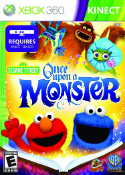


Comments